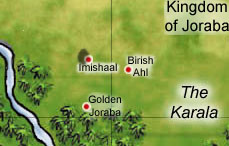Joraba

|
Once, the Kingdom of Joraba was a free nation. Home to a small pantheon of gods, Joraba once maintained a caste system within its society, each caste of which was representative of one of the gods of the Jorabani. The laborers wore their hair long and marked their foreheads with two curving lines in grey ochre, in emulation of the tusks of Ugaji, the elephant-headed god of labor and physical work (Temperance). The soldiery marked their foreheads with red ochre, for the blood that they spilled, and in emulation of the color of crimson-skinned Bahari, the tiger-headed god of warriors and spear-battle (Valor).
The priesthood marked their heads with a single yellow mark, celebrating golden-skinned Dirkashi, the god of sacrifice and incense (Conviction). The nobility marked their foreheads with the pure white mark (and included hanging white pearls in their headdresses) for Lafaia, the crowned goddess of nobility and riches (Compassion).
Even the outcaste, who were considered unclean, wore black marks upon their brows, marks in honor of Naramun Dasraja, who was not actually a goddess, but a concept – that of death and filth. It was they who were responsible for dealing with corpses and the filth that any civilization accumulates, and the wisest among them cared for the Ashfields, a haunting shadowlands where the ash of burnt sacrifices and the cremated dead were taken to be deposited in honor.
But all this changed with the coming of the Realm fifty years ago. They arrived first under a flag of negotiation and then eventually came in force, "pacifying" the Jorabani. Even their gods were put to flight by the powers of the Immaculate monks, and soon the presence of a Satrap and his Dragon-Blooded entourage became the norm. Their faith was outlawed, their caste system overthrown and great walls were put up around the Ashlands, surrounded with circles of salt and wards against the dead.
In this time, however, an assassin cult has sprung up, with the intention of murdering the Dragon-Blooded. The locals claim that it is made up of only the outcastes, but the Dragon-Blooded know that this is simply another example of the Jorabani leaving their outcastes to do their dirty work. Men dressed in black, their foreheads marked with the old symbol of the outcaste, attempt to waylay any Realm citizens they encounter – some of them have even tried (and in a few occasions succeeded) at murdering Dragon-Blooded.
Contents
Golden Joraba
Captial of the Kingdom of Joraba
The capital of Joraba, seat of the Rajas of Joraba, is also home to the Satrap Cathak Naltir. It is perhaps the best pacified of the cities, and in many ways runs like any other Realm city, though its citizens are terribly dispirited. Every year or so, the Satrapy has to outlaw new ways of expressing former castes among the older generations, while the newer generations have begun to forget what their castes meant at all.
Imishaal
The City of Ash
The city at the edges of the Ashlands, Imishaal was the great Temple-City of Joraba, home to the largest temples to the gods of its people. At the very edge of the city, in the Quarter of Skulls, is the massive crematorium where the Sons of Dasraja, an order of mute outcaste morticians, brought the corpses of dead Jorabani for their last rites. Bodies were brought in the Door of Silence and exited into the Ashlands themselves, carried by the mute Sons to their final resting place.
Now, however, Imishaal is home to a garrison of Legionnaires, and a number of monks, who watch the temples, which are now manned by Immaculate monks who both perform the proper rites for the gods of the Jorabani (who have been incorporated into the Immaculate Philosophy's calendars) and keep an eye on the gods themselves, who have not emerged from the sanctums within their respective temples.
Ashlands
The Ashlands of Joraba are a shadowlands made up of several miles of strange honeycombed trenches and canyons, most of which are separated by no more than a foot of rock. Over these canyons have been built pavilions and foot bridges, allowing those who come here to pay their respects to the dead to remain above the canyons, for they are home to literal seas of ash, from hundreds of years of the ashes of sacrifices in temples and the cremated remains of all Jorabani. Once, any day would see a regular arrival of priests to deposit sacrificial ash and families to pay their respects to ancestors, but now the Ashfields are empty and forlorn both day and night.
Birish Ahl
Once the center of the military complex of Joraba, Birish Ahl underwent an incredible siege some fifty years ago, during the so-called Pacification of Joraba. Now its impressive elephant-riding cavalries are in the service of the Legions, and its spear-fighting generals have all bowed their heads to the Satrap. The Jorabani still have to fight off the tribal Karala, but they do so at the orders of the Satrap now – no more are brave enemies captured to be sacrificed on the altars of the tiger-god Bahari.